- Home
- Deborah Blum
The Poisoner's Handbook
The Poisoner's Handbook Read online
Table of Contents
PENGUIN BOOKS
Title Page
Copyright Page
Dedication
ONE - CHLOROFORM (CHCl) 1915
TWO - WOOD ALCOHOL (CHOH) 1918—1919
THREE - CYANIDES (HCN, KCN, NaCN) 1920–1922
FOUR - ARSENIC (As) 1922—1923
FIVE - MERCURY (Hg) 1923—1925
SIX - CARBON MONOXIDE (CO), PART I 1926
SEVEN - METHYL ALCOHOL (CHOH) 1927
EIGHT - RADIUM (Ra) 1928—1929
NINE - ETHYL ALCOHOL (CHOH) 1930-1932
TEN - CARBON MONOXIDE (CO), PART II 1933—1934
ELEVEN - THALLIUM (Tl) 1935—1936
EPILOGUE
AUTHOR’S NOTE
GRATITUDES
A GUIDE TO THE
NOTES
INDEX
AVAILABLE FROM PENGUIN
AVAILABLE FROM PENGUIN
Praise for Deborah Blum’s The Poisoner’s Handbook
“Blum’s combination of chemistry and crime fiction creates a vicious, page-turning story that reads more like Raymond Chandler than Madame Curie.”
—The New York Observer
“Blum’s brilliant book is many things at once: a science lesson, peppered with historical anecdotes, tucked inside a compelling narrative that, in the end, is perfectly pitched and compulsively readable.”
—Milwaukee Journal Sentinel
“Reads like science fiction, complete with suspense, mystery, and foolhardy guys in lab coats tipping test tubes of mysterious chemicals into their own mouths.”
—NPR, What We’re Reading
“One thinks of Erik Larson’s Devil in the White City . . . a book that gave splendiferously disgusting descriptions of horrible murders and did it so dextrously and intelligently that even readers who wouldn’t normally read a true crime book were happily sucked in. Deborah Blum’s The Poisoner’s Handbook: Murder and the Birth of Forensic Medicine in Jazz Age New York is that kind of book.”
—New Haven Advocate
“The Poisoner’s Handbook is an inventive history that, like arsenic mixed into blackberry pie, goes down with ease.”
—The New York Times Book Review
“Blum’s book is heavy on science, especially chemistry, but it’s also an excellent look at the lackluster state of public health in the Jazz Age.”
—Chuck Leddy, The Boston Globe
“In this bubbling beaker of a book, [Blum] mixes up a heady potion of forensic toxicology, history, and true crime. Her account of the ongoing battle between scientists and killers in Jazz Age New York is more startling than any CSI: NY script.”
—The Dallas Morning News
“The Poisoner’s Handbook is that rare nonfiction book that has something for everyone, whether you are a true-crime aficionado, a political history buff, a science geek, or simply a fan of well-written narrative suspense.”
—BookPage
“Her book is sure to appeal to mystery lovers, science nerds, and history buffs drawn to a captivating story of two men whose skill and dedication helped transform the criminal justice system.”
—Associated Press
“The pacing and rich characterization of a first-rate suspense novelist.”
—Publishers Weekly
“Caviar for true crime fans and science buffs alike.”
—Kirkus Reviews
“Blum has cooked up a delicious, addictive brew: murder, forensic toxicology, New York City in the twenties, the biochemistry of poison. I loved this book. I knocked it back in one go and now I want more!”
—Mary Roach, author of Packing for Mars: The Curious Science of Life in the Void, Bonk: The Curious Coupling of Science and Sex, and Stiff: The Curious Lives of Human Cadavers
“The Poisoner’s Handbook opens one riveting murder case after another in this chronicle of Jazz Age chemical crimes where the real-life twists and turns are as startling as anything in fiction. Deborah Blum turns us all into forensic detectives by the end of this expertly written, dramatic page-turner that will transform the way you think about the power of science to threaten and save our lives.”
—Matthew Pearl, author of The Last Dickens and The Dante Club
“The Poisoner’s Handbook is a wonderfully compelling hybrid of history and science built around eccentric characters. One scene reads like Patricia Cornwell and the next like Oliver Sacks. From movie stars and aristocrats to homicidal grandmothers and entrepreneurial gangsters, from the government’s poisoning of alcohol during Prohibition to the dangers of radiation and automobile pollution, Blum follows an amazing array of poignant tragedies through the laboratory of these crusading public servants.”
—Michael Sims, author of Apollo’s Fire and Adam’s Navel
PENGUIN BOOKS
THE POISONER’S HANDBOOK
Pulitzer Prize winner Deborah Blum is a professor of science journalism at the University of Wisconsin. She worked as a newspaper science writer for twenty years, winning the Pulitzer in 1992 for her writing about primate research. She is the author of Ghost Hunters, coeditor of A Field Guide for Science Writers, and has written about scientific research for the Los Angeles Times, The New York Times, The Wall Street Journal, Slate, Psychology Today, and Mother Jones. She is the president-elect of the National Association of Science Writers and serves on advisory boards for both the American Association for the Advancement of Science and the National Academy of Sciences.
PENGUIN BOOKS
Published by the Penguin Group
Penguin Group (USA) Inc., 375 Hudson Street, New York, New York 10014, U.S.A. ● Penguin Group (Canada),
90 Eglinton Avenue East, Suite 700, Toronto, Ontario, Canada M4P 2Y3 (a division of Pearson Penguin Canada Inc.)
Penguin Books Ltd, 80 Strand, London WC2R oRL, England ●Penguin Ireland, 25 St. Stephen’s Green, Dublin 2,
Ireland (a division of Penguin Books Ltd) ● Penguin Books Australia Ltd, 250 Camberwell Road, Camberwell, Victoria
3124, Australia (a division of Pearson Australia Group Pty Ltd) ● Penguin Books India Pvt Ltd, 11 Community
Centre, Panchsheel Park, New Delhi–110 017, India ●Penguin Group (NZ), 67 Apollo Drive, Rosedale,
North Shore 0632, New Zealand (a division of Pearson New Zealand Ltd) ●Penguin Books
(South Africa) (Pty) Ltd, 24 Sturdee Avenue, Rosebank, Johannesburg 2196, South Africa
Penguin Books Ltd, Registered Offices:
80 Strand, London WC2R oRL, England
First published in the United States of America by The Penguin Press,
a member of Penguin Group (USA) Inc. 2010
Published in Penguin Books 2011
Copyright © Deborah Blum, 2010
All rights reserved
While the author has made every effort to provide accurate telephone numbers and Internet addresses at the time of publication, neither the publisher nor the author assumes any responsibility for errors, or for changes that occur after publication. Further, publisher does not have any control over and does not assume any responsibility for author or third-party Web sites or their content.
eISBN : 978-1-101-52489-3
1. Poisoning—New York (State)—History. 2. Forensic toxicology—New York (State)—History.
3. Forensic science—New York (State)—History. I. Title.
HV6555.U52N373 2010
614’. 1309747109041—dc22
2009026461
The scanning, uploading, and distribution of this book via the Internet or via any other means without the permission of the publisher is illegal and punishable by law. Please purchase only authorized electronic editions and do not participate in or encourage electronic piracy of copyrightable materials
. Your support of the author’s rights is appreciated.
http://us.penguingroup.com
To the Haugen family—Dave, Helen, Peter (always),
Treaka—and in loving memory of Pamela.
PROLOGUE
THE POISON GAME
UNTIL THE EARLY NINETEENTH CENTURY few tools existed to detect a toxic substance in a corpse. Sometimes investigators deduced poison from the violent sickness that preceded death, or built a case by feeding animals a victim’s last meal, but more often than not poisoners walked free. As a result murder by poison flourished. It became so common in eliminating perceived difficulties, such as a wealthy parent who stayed alive too long, that the French nicknamed the metallic element arsenic poudre de succession, the inheritance powder.
The chemical revolution of the 1800s changed the relative ease of such killings. Scientists learned to isolate and identify the basic elements and the chemical compounds that define life on Earth, gradually building a catalog, The Periodic Table of the Elements. In 1804, the elements palladium, cerium, iridium, osmium, and rhodium were discovered; potassium and sodium were isolated in 1807; barium, calcium, magnesium, and strontium in 1808; chlorine in 1810. Once researchers understood individual elements they went on to study them in combination, examining how elements bonded to create exotic compounds and familiar substances, such as the sodium-chlorine combination that creates basic table salt (NaCl).
The pioneering scientists who worked in elemental chemistry weren’t thinking about poisons in particular. But others were. In 1814, in the midst of this blaze of discovery, the Spanish chemist Mathieu Orfila published a treatise on poisons and their detection, the first book of its kind. Orfila suspected that metallic poisons like arsenic might be the easiest to detect in the body’s tissues and pushed his research in that direction. By the late 1830s the first test for isolating arsenic had been developed. Within a decade more reliable tests had been devised and were being used successfully in criminal prosecutions.
But the very science that made it possible to identify the old poisons, like arsenic, also made available a lethal array of new ones. Morphine was isolated in 1804, the same year that palladium was discovered. In 1819 strychnine was extracted from the seeds of the Asian vomit button tree (Strychnos nux vomica). The lethal compound coniine was isolated from hemlock the same year. Chemists neatly extracted nicotine from tobacco leaves in 1828. Aconitine—described by one toxicologist as “in its pure state, perhaps the most potent poison known”—was found in the beautifully flowering monkshood plant in 1832.
And although researchers had learned to isolate these alkaloids—organic (carbon-based) compounds with some nitrogen mixed in—they had no idea how to find such poisons in human tissue. Orfila himself, conducting one failed attempt after another, worried that it was an impossible task. One exasperated French prosecutor, during a mid-nineteenth-century trial involving a morphine murder, exclaimed: “Henceforth let us tell would-be poisoners; do not use metallic poisons for they leave traces. Use plant poisons . . . Fear nothing; your crime will go unpunished. There is no corpus delecti [physical evidence] for it cannot be found.”
So began a deadly cat and mouse game—scientists and poisoners as intellectual adversaries. A gun may be fired in a flash of anger, a rock carelessly hurled, a shovel swung in sudden fury, but a homicidal poisoning requires a calculating intelligence. Unsurprisingly, then, when metallic poisons, such as arsenic, became detectable in bodies, informed killers turned away from them. A survey of poison prosecutions in Britain found that, by the mid-nineteenth century, arsenic killings were decreasing. The trickier plant alkaloids were by then more popular among murderers.
In response, scientists increased their efforts to capture alkaloids in human tissue. Finally, in 1860, a reclusive and single-minded French chemist, Jean Servais Stas, figured out how to isolate nicotine, an alkaloid of the tobacco plant, from a corpse. Other plant poisons soon became more accessible and chemists were able to offer new assistance to criminal investigations. The field of toxicology was becoming something to be reckoned with, especially in Europe.
The knowledge, and the scientific determination, spread across the Atlantic to the United States. The 1896 book Medical Jurisprudence, Forensic Medicine and Toxicology, cowritten by a New York research chemist and a law professor, documented the still-fierce competition between scientists and killers. In one remarkable case in New York, a physician had killed his wife with morphine and then put belladonna drops into her eyes to counter the telltale contraction of her pupils. He was convicted only after Columbia University chemist Rudolph Witthaus, one of the authors of the 1896 text, demonstrated the process to the jury by killing a cat in the courtroom using the same gruesome technique. There was as much showmanship as science, Witthaus admitted; toxicology remained a primitive field of research filled with “questions still unanswerable.”
IN THE EARLY TWENTIETH CENTURY industrial innovation flooded the United States with a wealth of modern poisons, creating new opportunities for the clever poisoner and new challenges for the country’s early forensic detectives. Morphine went into teething medicines for infants; opium into routinely prescribed sedatives; arsenic was an ingredient in everything from pesticides to cosmetics. Mercury, cyanide, strychnine, chloral hydrate, chloroform, sulfates of iron, sugar of lead, carbolic acid, and more, the products of the new chemistry stocked the shelves of doctors’ offices, businesses, homes, pharmacies, and grocery stores. During the Great War poison was established as a weapon of warfare, earning World War I the name “The Chemist’s War.” And with the onset of Prohibition a new Chemist’s War raged between bootleggers and government chemists working to make moonshine a lethal concoction. In New York’s smoky jazz clubs, each round of cocktails became a game of Russian roulette.
There was no way for the barely invented science of toxicology to keep up with the deluge. Though a few dogged researchers were putting out manuals and compiling textbooks on the subject, too many novel compounds had yet to be analyzed and most doctors had little or no training in the subject.
IN 1918, HOWEVER, New York City made a radical reform that would revolutionize the poison game and launch toxicology into front-page status. Propelled by a series of scandals involving corrupt coroners and unsolved murders, the city hired its first trained medical examiner, a charismatic pathologist by the name of Charles Norris. Once in office, Norris swiftly hired an exceptionally driven and talented chemist named Alexander Gettler and persuaded him to found and direct the city’s first toxicology laboratory.
Together Norris and Gettler elevated forensic chemistry in this country to a formidable science. Trailblazing scientific detectives, they earned a respected place in the courtroom, crusaded against compounds dangerous to public health, and stopped a great many Jazz Age poisoners in their tracks. As they determinedly countered the obstacles faced in each new case they developed innovative laboratory methods for teasing toxins from human tissue. Their scientific contribution became a legacy for future generations.
But this story begins before Charles Norris or Alexander Gettler took office, before forensic toxicology was considered a fully legitimate science. It begins in the gray of a frozen January in the city, when an unlikely serial killer decided to make his move in the poison game.
ONE
CHLOROFORM (CHCl3) 1915
IT WOULD, OF COURSE, be in the cursed winter of 1915—when ice storms had glassed over the city, when Typhoid Mary had come sneaking back, when the Manhattan coroner was discovered to be skunk-drunk at crime scenes—that the loony little porter would confess to eight poison murders.
At first the confession seemed just more of the general craziness spiking across the city. New York was mired in winter, horse-drawn carriages careening through snow-drifted Broadway, trolleys stuck in place from the Bronx to Coney Island as the weight of ice dragged down the lines. The streets commissioner had hired fifteen thousand “snow fighters,” as he called them, to dig out the roadways. Even a
s the fighters shoveled and chopped, new snow dropped, new sleet kept falling, laying down yet another treacherous layer.
During those same days of darkening skies and frozen streets, public authorities were desperately trying to stop a sudden outbreak of typhoid fever. The city’s most notorious carrier, Typhoid Mary Mallon, had violated the conditions of her release from a sanitarium and gone to work as a cook at a local hospital. Twenty-five people were sick and two dead before they managed to hunt her down and take her—screaming and cursing them for persecution—back into custody.
THE CITY’S coroner had been no help in that investigation, if indeed he ever was.
Instead, Patrick Riordan was trying to fast-talk himself out of charges that he showed up for work sodden drunk. Or as one angry witness put it, he stumbled into a death scene with “a glassy eye and smirky face” to sneer at bodies. That indictment followed an accident on the Ninth Avenue Elevated, the crowded commuter line run by the private Interborough Rapid Transit Company.
The collision had occurred several weeks earlier, in the last days of December. Newspapers described it like a scene from a circle of hell—brakes failed on a local, metal and flame exploded as it went slamming into the back of an express waiting at the Eighth Avenue and 116th Street station. The impact had pushed the wooden cars upward into a blazing pyramid. Flying sparks then set the platform on fire. Passengers, dazed and bloody, fled to the street, stumbling down the rickety stairs from the seventy-five-foot-high track, crowds gathering in the fire-lit dark to catch them if they fell. Two train workers died in the crash. Dozens more workers and passengers went to the hospital seeking treatment for burns, lacerations, and shock.

 Love at Goon Park: Harry Harlow and the Science of Affection
Love at Goon Park: Harry Harlow and the Science of Affection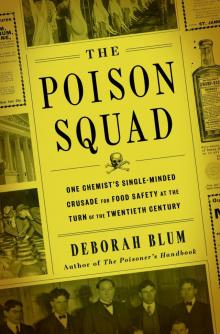 The Poison Squad
The Poison Squad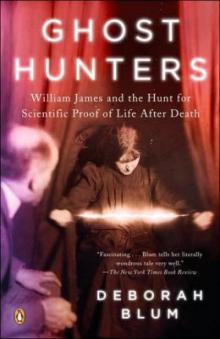 Ghost Hunters: The Victorians and the Hunt for Proof of Life After Death
Ghost Hunters: The Victorians and the Hunt for Proof of Life After Death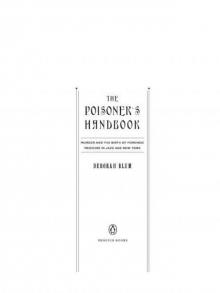 The Poisoner's Handbook
The Poisoner's Handbook Angel Killer
Angel Killer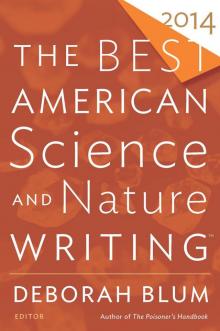 The Best American Science and Nature Writing 2014
The Best American Science and Nature Writing 2014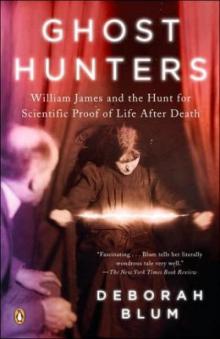 The Ghost Hunters
The Ghost Hunters Love at Goon Park
Love at Goon Park